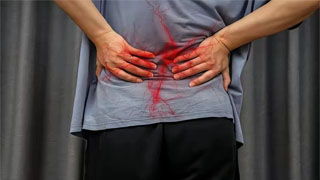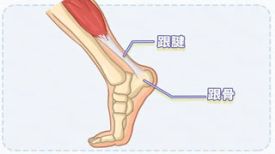
The importance of the spine goes without saying, as the muscles active around the spine also play a significant role. Under heavy pressure, they are naturally more prone to injury. Among them, the erector spinae muscle, which spans the longest distance and is one of the busiest muscles, bears the brunt.
The erector spinae, also known as the sacral spinalis, extends from the back of the sacrum to the back of the occipital bone and fills the deep groove between the spinous process and the rib angle. From the sacrum to the occipital bone, there are a pair of powerful extensor spinal muscles.
A straight waist and a strong physique are inseparable from the erector spinae muscle, which is an important muscle for keeping the body upright, maintaining spinal stability and balance. At the same time, it is also the source of explosive power in sports. In fitness exercises, the erector spinae muscle must play a role in stabilizing the core area. It is recommended to maintain a neutral position of the spine during any exercise, while tightening the abdominal muscles. The erector spinae muscles will also become excited, working together to maintain spinal integrity. The erector spinae is a long muscle located behind the spine, extending from the back of the sacrum to the back of the occipital bone and filling the groove between the spinous process and the rib angle.
Anatomical structure of erector spinae muscle
The erector spinae muscle originates from the dorsal aspect of the sacrum, the spinous process of the lumbar spine, the posterior part of the iliac crest, and the fascia of the lumbar spine. The muscle bundle gradually divides into three parallel longitudinal muscle columns from the inside out. The outer side is the iliopsoas muscle, which is divided into lumbar iliopsoas muscle, dorsal iliopsoas muscle, and nuchal iliopsoas muscle; The middle part is the longest muscle, which is divided into the longest muscle of the waist and back, the longest muscle of the neck, and the longest muscle of the head; The inner side is the spiny muscle, which is divided into thoracic spiny muscle, cervical spiny muscle, and head spiny muscle.
1. The total bundle originates from the dorsal surface of the sacrum, lumbar spinous process, posterior iliac crest, and lumbar fascia. The muscle bundle gradually divides into three parallel longitudinal muscle columns from the inside out.
The outer side is the iliopsoas muscle (divided into lumbar iliopsoas muscle, dorsal iliopsoas muscle, and nuchal iliopsoas muscle); The middle part is the longest muscle (divided into the longest muscle of the waist and back, the longest muscle of the neck, and the longest muscle of the head); the inner part is the spiny muscle (divided into the spiny muscles of the chest, neck, and head). Terminate at the lower edge of the rib angle, the transverse processes of the cervical and thoracic vertebrae, the mastoid process of the temporal bone, and the spinous processes of the cervical and thoracic vertebrae. Among them, the longest muscle is the strongest, while the spiny muscle is the weakest.
2. When fixing, both sides contract to extend the head and spine, and the iliopsoas muscle also has a rib lowering effect; Contraction on one side causes the spine to bend towards the same side. This muscle is innervated by the posterior branches of the cervical, thoracic, and lumbar nerves. The erector spinae muscle is the most vulnerable to injury in the back muscles. Its function is to pull the spine to achieve a backward tilt. The deep part of the erector spinae muscle is a short muscle with obvious segmental characteristics, connected between adjacent vertebrae or several vertebrae, which can enhance the connection between vertebrae and the flexibility of spinal movement. The erector spinae muscle is innervated by all posterior branches of the spinal nerves. Often times, injuries to the erector spinae muscle can cause severe nerve pain.
3. The erector spinae muscle plays a significant role in spinal statics (posture). Exercises such as lifting barbells, bending and stretching weight-bearing bodies, and swinging prone arms and legs can develop the strength of this muscle.
The influence and significance of erector spinae muscle (posterior muscle) on the spine
As one of the important muscles in the human body, erector spinae has a significant impact on the health and stability of the spine.
Firstly, the contraction of the erector spinae muscle can provide support and protection for the spine, preventing damage during exercise. For example, when people perform movements such as bending over, sit ups, etc., the erector spinae muscles contract and support the spine to maintain body stability.
Secondly, the degree of development of the erector spinae muscle also has a significant impact on the stability and health of the spine. If the erector spinae muscles are in a state of tension or undergo pathological changes for a long time, it may cause stiffness, pain, and imbalance in the spine, leading to a series of health problems such as cervical spondylosis and lumbar disc herniation.
In addition, the exercise of erector spinae muscles is also one of the important means to maintain spinal health. Through appropriate exercise, the strength and elasticity of the erector spinae muscles can be enhanced, the stability and endurance of the spine can be improved, and the degeneration and injury of the spine can be prevented.
In summary, the erector spinae muscle has a close relationship with the health of the spine and the human body. Maintaining the health and development of the erector spinae muscle is of great significance for maintaining human health and preventing spinal diseases.
The analysis of lumbar load and electromyography results proves that in biomechanical studies of lumbar load and erector spinae muscle activity under various sitting positions, the greater the forward tilt angle of the spine, the greater the load borne by the muscles and soft tissues around the lumbar spine, which is more likely to cause fatigue and even chronic damage to the lumbar, especially back soft tissues. Therefore, when sitting, it is advisable to maintain a relatively small anterior tilt angle of the spine to reduce the load on the muscles and soft tissues around the spine, delay muscle fatigue, and prevent lumbar soft tissue diseases.
It starts from the dorsal aspect of the sacrum, the spinous process of the lumbar spine, the posterior part of the iliac crest, and the thoracolumbar fascia, and is divided into three parts upwards: the lateral side is the iliocostalis of the iliocostalis muscle, which ends at the rib angle; The longest muscle, longissimus, is located in the middle and terminates at the transverse process and adjacent ribs; The inner side is spinalis, which terminates at the spinous process. Each muscle also has a series of small muscle bundles originating from auxiliary starting points: the auxiliary small muscle bundles of the iliopsoas muscle originate from the iliac crest, rib angle, and cervical transverse process; The small muscle bundles of the longest muscle originate from the sacrum, rib angles, and all transverse processes;
The small muscle bundles of the spiny muscles originate from the spinous processes of the thoracic and cervical vertebrae. Simultaneous contraction of both sides of the erector spinae muscle can cause the spine to extend backwards, which is an important structure for maintaining an upright posture in the human body, hence it is also known as the erector spinae muscle. Contraction of one erector spinae muscle can cause the trunk to bend towards the same side. The erector spinae muscle is innervated by all posterior branches of the spinal nerves.
The muscles behind the spine (erector spinae muscles) are of great help in maintaining the stability of the spine. They play an important role in preventing accidental spinal injuries, maintaining spinal stability, and preventing spinal degeneration. Most spinal degenerative diseases are closely related to the stiffness and weakness of the muscles behind the spine, which in turn are related to chronic muscle damage and lack of exercise caused by maintaining the same posture for a long time. Clinical studies have confirmed that targeted muscle rehabilitation exercises can reduce the recurrence rate of lumbar disc herniation and cervical spondylosis, as well as reduce the risk of spinal injuries.
The erector spinae muscle is crucial for maintaining spinal stability
The deep part of the erector spinae muscle is a short muscle with obvious segmental characteristics, connected between adjacent vertebrae or several vertebrae, which can enhance the connection between vertebrae and the flexibility of spinal movement. It also forms a second line of defense against external forces on the body, along with the rectus abdominis, internal oblique abdominis, external oblique abdominis, quadriceps, and gluteal muscles, which are crucial for maintaining spinal stability.
The erector spinae muscle is crucial for maintaining posture
The erector spinae muscle is an important structure for maintaining an upright posture in the human body. Bilateral contraction of the erector spinae muscle can stretch the spine, maintain its anti gravity upright state, and form antagonistic muscles with the abdominal muscles to maintain the stability of spinal eccentricity during trunk scoliosis. The erector spinae muscle is an important muscle for maintaining a straight and balanced body.
Unilateral contraction of the erector spinae muscle causes the spine to bend to the same side, and can also assist in complex rotational movements such as backward tilt, lateral flexion, rotation, and forward flexion (mainly braking and control during forward flexion). Simultaneously maintaining the stability of eccentricity during lateral bending of the contralateral muscle. This means that besides the upright posture, other spine related movements or postures are also difficult to complete without the support of erector spinae muscles.
The erector spinae and abdominal muscles are a pair of antagonistic muscles. When the erector spinae muscles tense and contract while the abdominal muscles are weak, it can cause pelvic anterior tilt and lumbar lordosis, which not only causes posture problems but also triggers a series of chain reactions such as lower back pain.
The erector spinae muscle is most relaxed when maintaining the optimal posture
The surface muscles of the spine, like the deep muscles of the spine, are most relaxed when standing and the center of gravity of the body is in the center. The same applies to the erector spinae muscles. Therefore, poor posture is likely to overload the erector spinae muscles and ultimately cause injury.
Exercise movements:
Lying prone with both ends up (Superman), the method is simple and can be completed on a yoga mat at home. Compared to standing up with a goat, it is somewhat similar, but the legs of a goat standing up are fixed, while lying down at both ends is like double standing up to exercise the waist.
Target exercise area: erector spinae muscle (lower back or lower back), also able to exercise gluteus maximus muscle
Action essentials:
Lie completely relaxed on your stomach, with arms straight above your head and legs straight. When inhaling, lift both arms and legs up and off the ground, control slightly, and then slowly exhale to relax.
1. The body is in a prone position, with arms extended and palms facing each other.
2. Apply force to the back, stand up, and extend the hips while lifting both feet off the ground to form a recurve posture, then return to the starting position.
matters needing attention:
1. This action cannot be performed using explosive force, but should be slowly exerted by the abdominal muscles to lift the arms and legs
2. In addition, be careful not to tilt your head back too hard, but to lift it along with your upper body.
Swimming Stand Up:
Contra Aquatic Superman is somewhat similar to prone standing, but mainly exercises the waist from a diagonal angle, similar to the coordination of hands and feet (left and right feet, right and left feet) in freestyle to maintain body balance.
Target exercise area: erector spinae muscle (lower back or lower back), also able to exercise gluteus maximus muscle
Action essentials:
1. The body is in a prone position, with arms straight and raised above the head, legs straight and shoulder width apart.
2. Tighten the core and lift one arm and the opposite leg.
3. Return to the starting position and repeat the steps on the opposite side.
matters needing attention:
1. This action cannot be performed using explosive force, but should be slowly exerted by the abdominal muscles to lift the arms and legs
2. In addition, be careful not to tilt your head back too hard, but to lift it along with your upper body.
Prone and Stand Up
Action essentials:
1. The body is in a prone position, with arms bent at the elbows and hands placed at the ears.
2. Apply force to the back and stretch the torso backwards to create a recurve posture. At this point, your legs cannot leave the ground, keep your hands close to your ears, and then return to the starting position.
Dumbbell exercise:
The starting point of the erector spinae muscle can be seen to make your back straight when it contracts, which is the action of extending your trunk. If the erector spinae muscle does not have contraction force, then a lot of relaxation can cause problems with hunchback, waist, and cervical spine.
For example, due to lumbar disc herniation, training the erector spinae muscles is a necessary muscle group for our back training. Generally, we train 1-2 times a week with a minimum interval of 3 days between each session. This movement should be distinguished from the straight knee hard pull, which belongs to the leg hamstring muscle training movement. We should not confuse it and choose a suitable pair of dumbbells. The feet should be separated by the same width as the hips, and the knee joints should always be slightly curved. The dumbbell fists should be closed with both hands, and the eyes should naturally droop. The hips should be bent to make the trunk and thighs at a 90 degree angle, and the back should always be kept straight.
At this point, our starting position is as shown in Figure 2. Apply force to exhale and contract the erector spinae muscles for 1-2 seconds until we reach our endpoint position as shown in Figure 3. Pause for 1 second to reach the peak contraction, then inhale and relax the erector spinae muscles and slowly return to the starting position for 2-3 seconds. Each group consists of 8-12 muscles, and rest between groups for 45-60 seconds. Groups 3-5 are recommended. For friends with lumbar muscle strain or lumbar disc herniation, it is recommended to start with bare hands and gradually increase weight.
Straight arm flat support
Stand on the ground in a push up position, keep your waist and back straight, and keep your body in a straight line. Extend your arms straight, support your hands on the ground, with a distance slightly greater than shoulder width between your hands. Tighten the core, bring your legs together, and keep your toes on the ground, keeping your body stable for the specified time.


